Introduction |
|---|
I became interested in this post after reading @weisser-rabe post about how she handled a domestic accident that happened with her kid and situation that happened early this year in the Nigeria entertainment industry. I believe that before the end of this challenge, i will definitely have the required skills as a first responder.
Let me invite @ahsansharif, @bossj23 and @ochelebe for the challenge.
Share your any experience of your life, in which you faced the emergency that could be handled by your own only if you know the basic first response skills |
|---|
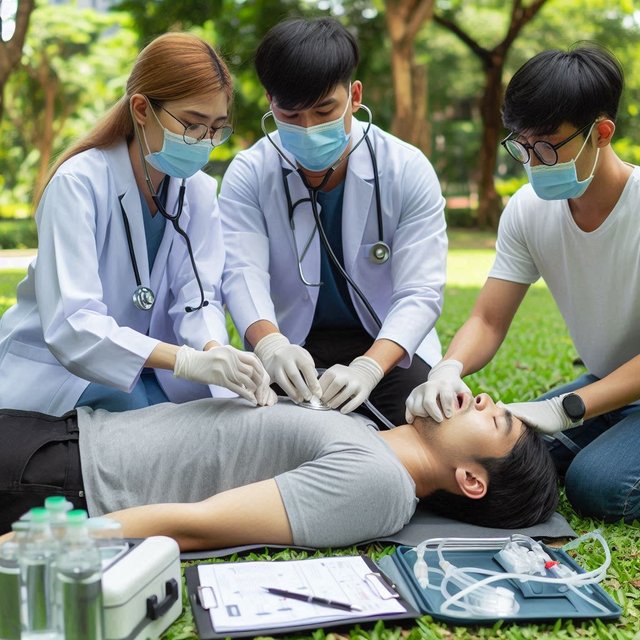
Generated by me with Bing AI
Just this year, a sad event happened in the entertainment industry that shook the country. An actor who was going for a movie shoot in a particular location, drowned while crossing the river as a result of boat mishap. It seemed as if he could foresee what would have happened to him while he was in the boat making his short video.
But that’s not even the saddest part. Shortly after the guy drowned, some of the villagers who could swim, dived in to see if they could rescue some of them but since none of them knew nothing about basic first aid, they took them to the morgue. It was the mortician at the morgue, who noticed that the actor was still alive. However, instead of trying to resuscitate him since the hospital was far from them, their instinctive reaction was to take him to a river local shrine to revive his spirit through spiritual means.
When the native doctor couldn’t conjure his spirit back, they finally decided to rush him to the same hospital they felt was too far but it was too late. While, I was watching the whole video on social media , I was seeing people’s comment saying “is there no one among the crowd that knows CPR to resuscitate him instead of taking him to a river shrine?” I now imagine myself been in such scenario, what would I have done since I don’t know the basic “first aid” given to victims who drown apart from what I see in movies
Imagine you are walking back home, when you witness a road traffic accident between a car and a motorcycle, and the motorcyclist is lying on the road, not moving. There’s some bleeding from his leg, and he appears to be unconscious. You being the first responder, how will you manage this scenario? |
|---|
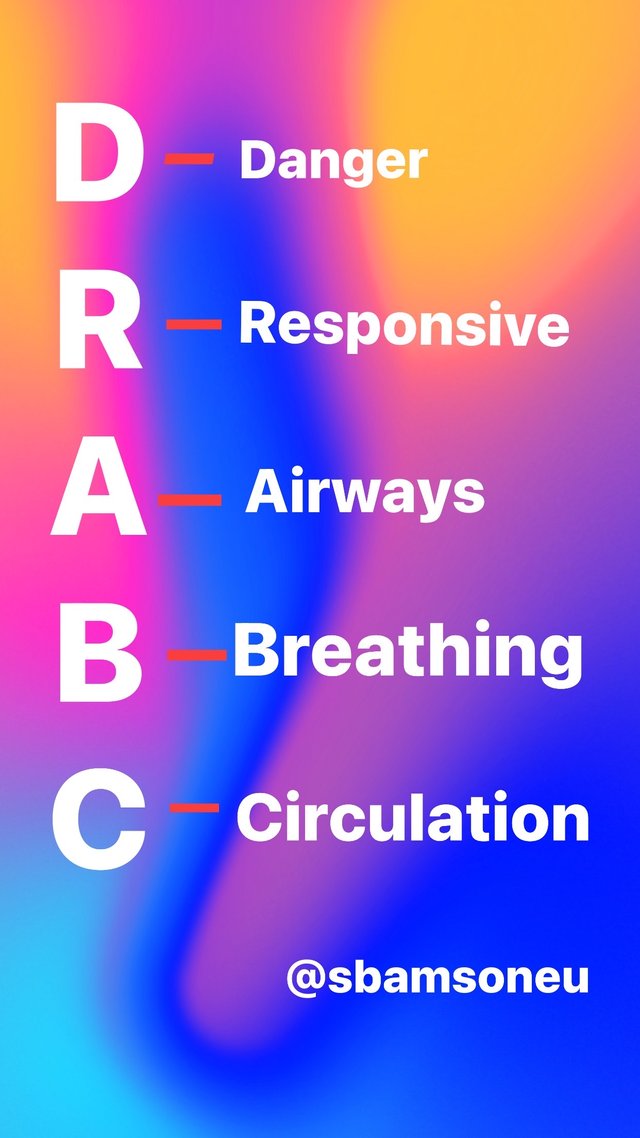
As a first responder who just witnessed a road traffic accident between a car and a motorcycle, with the motor cyclist lying on the road unconscious and bleeding severely, here’s how I would handle the situation to save the victims life using a systematic approach and the worldwide DRABC protocol:
Assess the situation
My first line of action is to observe and assess the scene of the environment to ensure it is quite safe for me. You don’t want me, running into a busy highway to save someone, when the coast isn’t clear, it will only put me in harms way. so, I’ve to check out for any incoming vehicles, or spilled fuel on the road or any sharp objects like pieces of glass.
It’s very clear that this road traffic accident can be categorized under “Trauma and Injury Emergencies”. Seeing the cyclists unconscious and his blood spilled on the floor indicates he’s in a critical situation.
- making sure the environment is clear and free from harm by waving down oncoming cars coming with high speed and controlling bystanders to stay at a safe distance to avoid another accident and to ensure adequate room for air in order for the victim to breathe properly.
Provide Basic Emergency Care Using the DRABC Protocol
Danger: I’ll do a quick scan around the scene of the accident before approaching cautiously In order to avoid stepping into immediate danger, such as sharp metals, pieces of glasses or fuel leakage that could cause explosions. My safety is very crucial, i need to be alive to perform the first aid on the victim.
Response: I will quickly assess the motorcyclist condition to see if he’s breathing or check for any visible injuries on his body besides his legs. if he’s responsive, I would avoid moving him unnecessarily because there could be neck or spinal injuries. I’d then call the emergency services or ask anyone close-by at the scene to reach them for me, to report the severity of the accident, so that the paramedics will know what equipment to bring and provide details about the location.
Airway: If the motorcyclist is unresponsive, I’ll try to disperse the crowd close to him, so he could have enough air around him, then I’ll carefully open his airways and lift his chin up, (using the head-tilt, chin-lift method) to prevent his tongue from blocking his airways. It’s also important to check in his mouth for any visible obstruction, such as blood or dirt. If it’s deep in his mouth, avoid it till the paramedics comes to take over.
Breathing: as a first responder, I’ll check for If he’s breathing, by taking note the rate and depth of his breaths. If he’s lucky to be breathing, I’ll place him in recovery position, meaning laying him down on the side to keep his airway open and reduce the risk of choking. If he’s not breathing, I move straight to administering CPR to the victim till the paramedics come.
Circulation: I will place three fingers on wrist or the side of the neck near the trachea to check for any pulse. If there is none, I’ll administer CPR straight away. To stop the bleeding on his legs, I’ll grab a clean cloth or my shirt if it comes to that, to apply firm and direct pressure on the wound to help control the blood loss and prevent shock. if it’s possible, I’ll carry injured legs upward or elevated position, to reduce the blood loss. Also avoid using a tourniquet unless the blood can’t be controlled.
Support Emergency Services Upon Arrival
Once the paramedics arrived, provide them with the overview of the whole situation in details:
- Described the road accident and anything you observed.
- Explain to them the administered first aid you use for the victim such as CPR and blood control
- Also mention to them, the changes in breathing, consciousness or any other injuries, if you observed any.
- Most of all, be very clear in your communication.
Stay Calm and Reassure the Casualty.
Draw or Create an engaging illustration/flowchart of DRABC protocol |
|---|
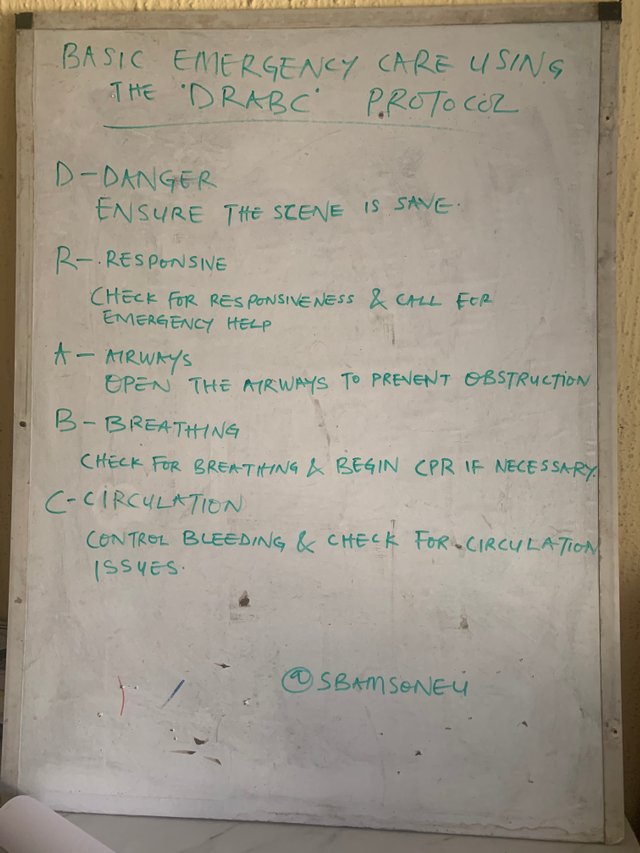
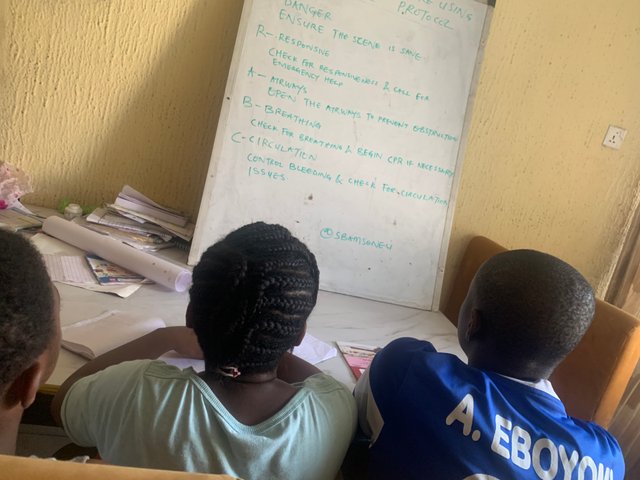
I decided to educate my nephew and niece on a little lecture on “basic first aid”, but it seems my niece was even more enlightened than me. They have taught her in class before. According to her, she said one alphabet is missing and is “letter S”. When I ask her what it means, she said it means to “scream for help”… i try to explain to her that the one she’s calling is under “responsive” she was still arguing with me.
According to her, it is not “DRABC” is called DR’s - ABC (Doctor’s ABC)… it was really fun learning a thing or two from her and to tell you the truth, it’s far easier for me to remember DR’s-ABC than to remember DRABC…
Write down the numbers of emergency services of your country/area on a paper |
|---|
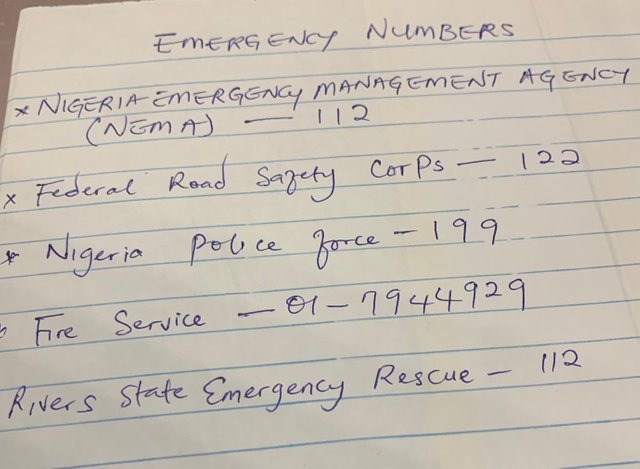
conclusion |
|---|
This particular challenge should be a must for everyone, as it educates people on the essential knowledge needed to save lives if they find themselves as first responders. DRABC, should be at the fingertips of everyone because you never can tell when it will be of great help to you.
Student Name: @sbamsoneu
Time of checking: Within 24 hours of the homework
Overall Grade: [7.9/10]
Plagiarism Check: Pass
AI Use: No
General Feedback:
Overall, you demonstrated an excellent understanding of first aid protocols and emergency response techniques. Enhancing your responses with more detailed descriptions and dynamic visuals will help bring further depth and clarity to your work. Keep refining these valuable skills—they're essential for becoming an effective first responder.
Thank you.
Regards,
@abdu.navi03
Downvoting a post can decrease pending rewards and make it less visible. Common reasons:
Submit
Your niece is great. She definitely has a good sense of imagination and thought support...
Downvoting a post can decrease pending rewards and make it less visible. Common reasons:
Submit